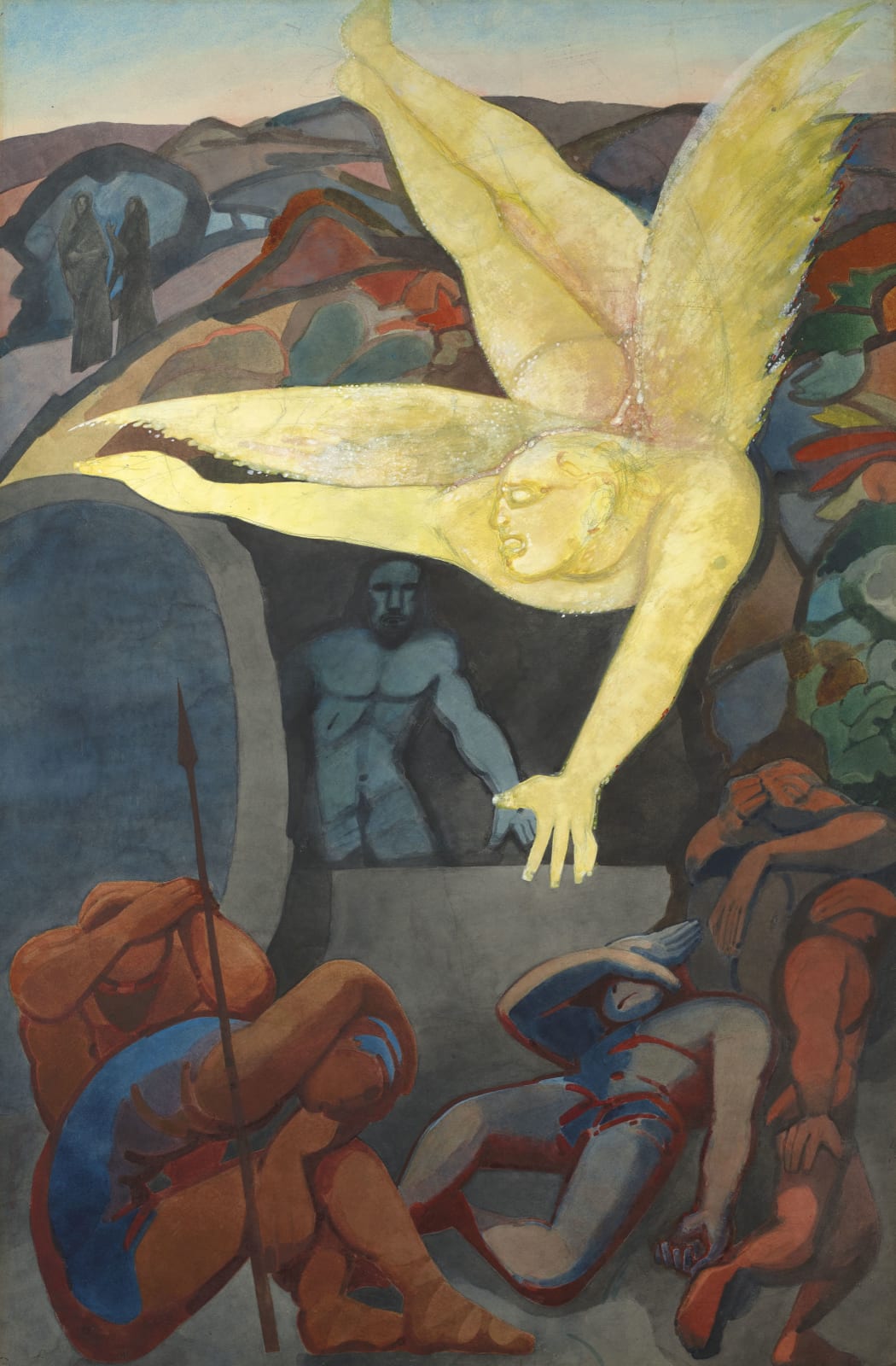Edward Burra 1905-1976
102.2 x 66.7 cm
It seems as if at this particular time, the art of counter-Reformation Catholicism provided Burra with a series of reference-points for expressing passionate feeling, chiefly of wrath and horror. This painting is based on Matthew 28: 2-4: ‘There was a great earthquake, for the angel of the Lord descended from heaven, and, came and rolled back the stone from the door and sat upon it. And his countenance was like lightning, and his raiment white as snow. And for fear of him the keepers did shake, and became as dead men’. Thus in this intensely dramatic painting, a massive angel, yellow-white as molten metal, rolls away a great stone from the door of the tomb with one easy push; while a tangle of soldiers in the foreground are dead or fainting. Christ, a stern and powerful figure with steely blue flesh, steps forth from his tomb with the ponderous tread of a zombie.
While not conventionally religious, Burra had a strong sense of the supernatural. He wrote in February, 1940, about Frederick Ashton’s powerful symbolic ballet, Dante Sonata, ‘I would like to see Freds new piece it sounds very good any thing to do with the powers of evil dearie. Im a great believer in them’.2 He often painted demonic figures and spirits of one kind or another, but in the late forties, he also created two images of angels, of which this is one. Both are seraphim, the highest angelic order; since they are portrayed as creatures of fire. They are not gentle messengers, but alarmingly powerful supernatural forces.
Specific images which might have helped to inform Burra’s composition include Caravaggio’s Sette Opere di Misericordia, painted for the church of the Pio Monte della Misericordia in Naples (where it still is), which has clearly influenced his own angel’s pinwheel of arms and wings. Cecco del Caravaggio’s Resurrection, which similarly features an alarmingly purposeful and powerful angel, may also be a reference point, as may Tintoretto’s Resurrection in the Ashmolean, with its soldiers falling like skittles. The exceptionally formidable risen Christ in Piero della Francesco’s Resurrection, and again, the collapsed soldiers in the foreground, may also have been in Burra’s mind. Apart from the Tintoretto, he could only have seen these pictures in reproduction, but he collected art books, and studied them with attention. Additionally, the treatment of the angel, with its angular wings, evokes the English Romantic painters, notably Blake and Fuseli: in the summer of 1947, around the time this picture was painted, Burra was admiring the Tate’s Blake collection, and bought Ruthven Todd’s 1946 book on the Romantics, Tracks in the Snow. Resurrection thus brings together two important strands of Burra’s engagement with other painters; Catholic baroque, and the very English art of Blake.
Professor Jane Stevenson
1 Private correspondence, Edward Burra to Conrad Aiken, 15 January 1950, San Marino, California, Huntington Library, AIK 2197–2380
2 W. Chappell (ed.), Well Dearie, the Letters of Edward Burra, London, 1985, p105
Provenance
with Lefevre Gallery, London,
March 1988
Stanley J. Seeger
Private Collection, Switzerland
Exhibitions
London, Lefevre Gallery, Edward Burra, Paintings from America,
March - May 1980, cat no.8
Literature
Lefevre Gallery, London, Edward Burra, Paintings from America, exhibition catalogue, 1980, pp18-19, illus no.8
Andrew Causey, Edward Burra Complete Catalogue, Oxford, 1985, illus no.191



